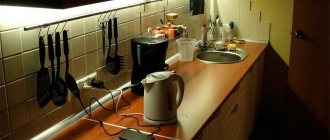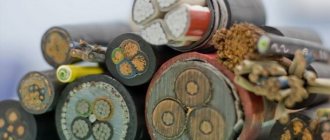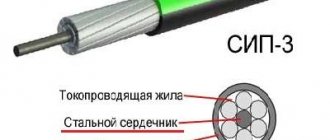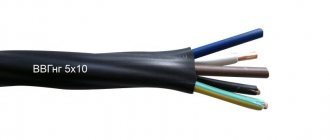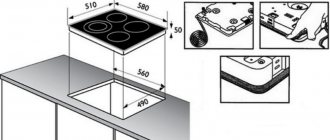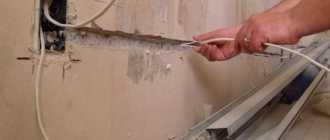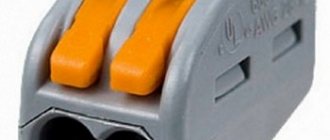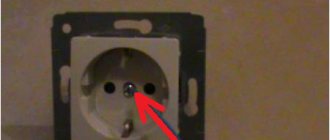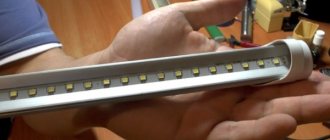Independent connection of an electric stove to a 220 V, 380 V network
Electricity is a serious and dangerous matter, but many jobs do not require high qualifications and can be done independently without the involvement of specialists. For example, you can connect an electric stove with only a vague understanding of electricity. Especially if the outlet is already installed. All that remains is to install a plug on the cord and connect it correctly to the connectors of the stove. The situation is worse if it is necessary to pull the line from the shield, but even here you can cope without help. Just remember that all work is carried out with the power supply turned off.
Connection diagram and methods
Electric household stoves are powerful equipment; the current they consume is about 40-50 A. This means that the electric stove must be connected to a dedicated power line. It must be powered directly from the apartment or house panel. Power is supplied through an RCD and a circuit breaker. The stove itself can be connected via a socket and plug (special power ones) and a terminal box. Also, the line from the machine can be directly connected to the input terminals on the rear wall.
Electric stove connection diagram
A more reliable connection is directly to the input terminals of the plate. In this case, there is a minimum number of contact points, which increases reliability. But this method is not entirely convenient: you can only turn off the power automatically. About the same problem occurs when using a terminal box, the only difference being that there are more connection points.
The most commonly used connection is a socket and plug. It's more convenient and familiar. Since the equipment is powerful, they use not ordinary household devices, but special ones, which are also called power devices - for their ability to withstand significant current loads.
Please note that when connecting powerful electrical equipment, grounding is required. Without it, you will be denied warranty repairs, and its absence is life-threatening, so it’s better not to take risks.
Connection to a single-phase network
Before starting work, be sure to study the instructions for installing sockets for electric furnaces, as this process requires at least a little preparation.
The plug for a 220 volt power supply is equipped with three terminals:
- phase;
- zero;
- protective (grounding).
In practice, their generally accepted color marking is provided, so phase wiring is painted red, white or brown, the neutral working cable is blue, and the grounding cable is yellow.
These pins must be connected to the corresponding pins on the plug. Afterwards there is a direct connection to the tile. On its back wall there is a panel necessary for connecting to the network. There are 6 terminals on the panel, marked with special symbols L1, L2, L3; N1 and N2; P.E.
Contacts marked with the Latin letter L are used to connect a phase output to them. If the connection is single-phase, be sure to make a jumper between the existing terminals and add a wire from the power supply to one of them.
Contacts N1 and N2 are required to connect the neutral cable. A jumper is placed between them, if this is not provided by the stove manufacturer, and the cable is connected to one of the terminals.
The PE contact is used to connect the protective (grounding) wire. This is considered the final stage of preparatory work.
Electrical parameters and ratings of circuit breakers
As we found out, there should be separate RCDs and a circuit breaker in the electrical panel. Through them the phase is supplied to the socket. This pair can be replaced with a difavtomat. These are the same two devices, but in one case. The negative is taken from the common bus, passes through the RCD, and the grounding is taken from the corresponding bus.
The rating of the machine is selected based on the maximum current consumption. This data is in the electric stove's passport and is usually in the range of 40-50 A. In this range, the ratings come in large increments - 40 A, 50 A, 63 A. It is better to choose the nearest larger one - this way there is less chance of a false shutdown when operating at full power . That is, if the declared maximum current consumption is 42-43 A, still take a 50 A machine.
Electric stove connection diagram
On the other hand, you may never turn on all the burners and oven, and even at full power, and more powerful machines are significantly more expensive. It's up to you to choose.
The rating of the RCD is taken one step higher than that of the machine. If you decide to install a 50 A machine, then the RCD is required at 63 A, the leakage current is 30 mA.
When choosing an electric stove, they don’t think about this, and then they bite their elbows
In previous topics, apartment panel diagrams were discussed, including for an apartment with an electric stove, and today we will consider in detail the choice of an electric stove. Choosing an electric stove is quite a quest, given the many manufacturers, such as the stoves themselves and their models.
But still, buying an electric stove is half the battle. I will mainly talk about how to properly organize the connection of this equipment. To ensure that no unexpected problems arise after delivery and installation. And, after hundreds of cooked omelettes and pots of soup, you have never witnessed a conflict between powerful household appliances and home electrical wiring.
How to choose a good, even ideal, electric stove?
Electric stove for an apartment
To prevent your ideas about comfortable cooking from being destroyed in the future, you will have to rack your brains in the present: study the modern assortment, user reviews, ratings and reviews. Of course, take into account your personal aesthetic component.
Judging by the assortment of household appliances stores, most often housewives prefer a built-in work surface and a separate oven, but “classic” combined models are also presented in abundance.
When looking closely, you will definitely take into account the main factors. Thus, the hob can be metal or enameled, glass-ceramic or stainless steel.
The simplest electric stove
When it comes to burners, also choose not only by their number (the most popular are from 2 to 5 pieces), but also by type:
- cast iron “pancakes” slightly protruding above the surface level, inside of which heating elements are hidden. They heat up slowly, since cast iron “voraciously” absorbs heat, which increases energy costs. But, classic burners cool down gradually. If you adapt, it can even be convenient for preparing some dishes;
- heating elements hidden in the panel, externally indicated only by an outline, warm up faster and, therefore, are more economical in terms of energy consumption.
A separate group is induction cookers. They are considered the most innovative and differ in their operating principle. The magnetic field created with the help of an inductance coil and a generator (located under the glass-ceramic panel) almost instantly directly heats up the special(!) cookware, and not the hob itself. That is, maximum energy efficiency is ensured, and the cooking time is reduced by 2-3 times.
Please note that cookware suitable for the miracle stove is marked with a special marking in the form of an upward spiral. Check to see if you have one, or if you'll have to fork out for a new set of pans and pots.
How does functionality affect the price of a stove, and what should you not overpay for?
All sorts of useful functions also cannot be ignored:
- “quick start” is a function, when turned on, the burner starts working immediately at the maximum temperature setting, which reduces the time to warm up. Convenient for those who are always in a hurry;
- “anti-spill” - if a boiling mass from the cookware spills onto the panel, the burners automatically turn off. This way the surface can be cleaned in time, without waiting for the burnt layer;
- blocking from accidental activation by children is definitely a godsend for families with children;
- timers and built-in cooking programs - a kind of “autopilot” mode, in which the oven independently regulates the temperature, turns convection on and off, and turns off at a given time. It's up to you to decide: who is the master chef in your kitchen?
What do the inscriptions “A+” and “A++” mean, and what is the difference?
In light of rising tariffs, you are unlikely to ignore the energy consumption class: A+ and A++ are preferred. This marking indicates the most energy efficient ones. That is, more economical slabs have not yet been invented.
Energy efficiency of the stove
Some people prefer “old school” cast iron burners, while others choose modern-looking glass-ceramic panels with hidden heating elements. Some people choose classics and reliability, while others choose ultra-modern technological and design solutions. All of the above factors are subjective.
However, there is a factor that is perhaps more important than functionality and design. This is the power of the stove. Current electric stoves for household use are endowed with power that is sometimes comparable to industrial equipment and reaches 10 kW and above.
This means: you won’t be able to ignore the connection features. Whatever brand, series and model you ultimately choose, one rule applies: an electric stove needs to be properly connected to the power supply. And it is important to take care of this “at the start,” before purchasing it.
Electrical wiring is an area of increased attention.
Connecting an electric stove
If you do not “click” the essential points of the connection process, you will be sure that your favorite stove will serve faithfully for many years.
Let's deal with sockets.
In the vast majority of cases, a household stove is plugged into a 220V outlet - habitually, simply and logically. But not every outlet is suitable for connection.
Let's look at the numbers. Most often, the stove has four burners. On average, each of the burners consumes about 1.5 kW (the exact figures are indicated in the technical data sheet for the equipment).
Is it possible for all burners to be turned on at the same time? Of course, you never know the reasons to throw a feast for the whole world. We determine the maximum load:
1.5 kW x 4 pcs = 6 kW.
What socket rating is needed in this case?
I=P/U=6000W/220V=27.3 A.
Electric stove current consumption
If there are 5 burners on the stove, which is not uncommon in the world of modern household appliances, count on all 32 A.
At the same time, most sockets in our homes are designed for a rated current of 16 A. This is enough to connect a maximum load of 3.5 kW (for example, a two-burner model).
If you simply replace your old equipment with a new one with approximately the same power, there will be no problems. Your wiring is already “tailored” to the required load, although it still doesn’t hurt to check the main points.
If the connection is being made in an apartment for the first time, what is the right thing to do?
By the way, often the package does not include a plug and cord, and the passport specifies the required cross-section of the electrical cable for connection.
What to do with all this?
So, there are 2 possible ways.
The first option is WRONG and dangerous.
Take a chance and plug it into a regular household outlet.
Wrong choice of socket for the electric stove
Forecast: overheating of the outlet due to excessive load and an emergency situation.
If the wiring in the apartment is done correctly, and the circuit breakers and RCDs in the panel are selected professionally, based on calculations, then they will work and de-energize the line before serious problems arise (perhaps the socket will have time to melt).
It is much worse if the electrical wiring is done “by eye”, without mathematical justification, and the “automatic” is selected with a reserve. Then it will probably work later than necessary - and the fire is not far away.
Remember: one standard outlet can connect devices with a power of up to 3 kW (including those with an extension cord).
The second option is correct and reliable.
Socket for electric stove
Install special sockets. Their main difference is the increased current rating. They have long been used in everyday life: back in Soviet times, special electrical accessories of the RSh-VSh series were produced to connect electric stoves. Black and not very nice design.
And you will find modern models for connecting stoves (with high reliability and also visually pleasing) in any more or less large electrical equipment store. You can choose from options:
- cheaper: from IEK, for example, surface-on or flush-mount connectors and 32 A plugs.
- more expensive: from the French manufacturer Legrand. This is the most thoughtful design, reliable and convenient mechanism - after all, the product of a world-famous manufacturer of electrical accessories. Options are also available for three-phase cookers.
If you intend to install it behind a stove, which is subsequently pushed tightly against the wall, choose a model for hidden installation.
Having dealt with the socket, we move on to choosing the power cord. This is also an area of increased attention.
We power it with a suitable cable.
Cable for electric stove
The electric stove is powered by a separate copper cable from the panel with a cross-section of 6 mm2 (up to 8-10 kW). For a single-phase home electrical network, a three-core cable is suitable, for a three-phase - a five-core cable. For three-phase electric stoves and low-power electric stoves, the cross-section can be taken smaller. The cross section will depend on the rated current of the protective device.
As for the brand of wire: it can be PVS or VVG (for example, PVS 3×6.0). The first one is more flexible and easier to install. VVG is cheaper, but hard, especially with a significant thickness. In any case, we advise you to provide some margin in length.
Have you chosen a cable? Now take care of protecting it from possible emergency situations.
We protect the line “automatically”.
A separate circuit breaker must be installed specifically on the electric stove line to protect against overload and short circuit currents. The denomination cannot be selected “by eye”, but only based on mathematical calculations. Moreover, it is not at all difficult.
Let's take the same example as above, with a maximum load of 6kW. The maximum current consumption, as we determined, will be 27.3 A. In the case of an automatic machine, we can add a margin of 15-20% (no more to ensure adequate operation):
27.3A+15% 31.4A.
Next, we select in the store the circuit breaker of the closest value (always upward), and this is 32 A.
In addition to the “automatic machine,” I recommend installing another compact module in the apartment panel - an RCD (residual current device).
We increase safety with the help of RCDs.
An extremely important task of the RCD is to instantly turn off the power if leakage currents (so-called differential currents) suddenly arise. This is an emergency wiring condition in which there is a high probability of fire or electric shock to a person.
Connecting an electric stove with a separate line
It is ideal when, when connecting an electric stove, a circuit breaker (for protection against overcurrents) and an RCD (for protection against leakage currents) work in pairs.
Select a residual current device for the stove as follows:
- the rated current is one step higher than for the “automatic machine” - this is the next of the existing ratings (for our example it is 40 A);
- sensitivity to leakage current is 30 mA, sufficient to protect the human body. The more sensitive 10 mA is not recommended. Since this will lead to false positives and shutdowns. Sometimes they even install a 100 mA RCD for an electric stove if natural leakage currents exceed 10 mA;
- choose the type “A” marking - such an RCD will also respond to differential currents inside the electrical appliance itself.
Using these parameters, you can easily and independently select an RCD in the same online store of the electrical company. There you can contact a specialist online for help in choosing.
So, let's summarize:
To connect your new, beautiful, productive and powerful stove you need:
- Copper cable from the panel;
- Separate circuit breaker and RCD with corresponding characteristics;
- Special socket with increased rating of 20 A or 32 A.
Any more or less experienced electrician can handle this complex task. But prepare good sockets and reliable protection devices in advance - better than European brands and from a trusted store.
I recommend reading:
Selecting a transformer winding connection diagram
Selecting a protective device in lighting networks for high-risk premises
Internal diameter of pipes when laying cables in the ground
Choosing a grill guard
Wire and its parameters
In recent years, when laying electrical wiring and connecting household appliances, copper conductors are most often used. Although they cost much more, they are more convenient to work with, and besides, copper requires a much smaller core diameter than when using aluminum conductors.
The conductor cross-section is selected depending on the type of network - 220 V or 380 V, the type of wiring (open/closed) as well as the current consumption or power of the equipment. Typically, copper conductors with a core of 4 mm (for line lengths up to 12 m) or 6 mm are used.
Conductor cross-section selection table
When choosing the type of cable to lay from the panel to the outlet, it is better to choose single-core conductors. Although they are more rigid, they are more reliable. To connect the stove itself (to which you will need to connect the power plug), you can choose a flexible stranded wire: a single-core wire in this case will be too inconvenient.
Connecting the cable to the electric stove
To connect an electric stove, be sure to use a dedicated line with a circuit breaker from the apartment panel or house switch. The rating of the machine is also selected depending on the current consumed by the stove, rounded up, most often within the range of 40-50A.
There are 3 main ways to connect electric stoves:
- wire from the input terminals to a special power socket
- via terminal box
- directly with a power cable from the panel to the input terminals
The second and third methods are considered more reliable, but inconvenient, since if you need to turn off the power, you need to turn off the machine in the panel.
Electric stove connection diagram via terminal box
Connecting an electric stove with a socket and plug is the most common and familiar method. To familiarize yourself with the connection technique using this method, we recommend that you watch the video below.
How to connect an electric stove to a 220 V network
All the above diagrams were specifically for a single-phase 220 V network. To connect, you will need a three-wire cable, a three-pin power socket and a plug with a rated current of at least 32 A. Let’s say right away that connecting equipment from different brands is fundamentally no different. It doesn’t matter which stove you purchased - Electrolux, Gorenje, Bosh, Beko. Doesn't matter. The only difference is the different design of the covers that cover the terminal box on the housing and different methods of fastening it. Everything else is the same.
Connecting the cable to the electric stove
First, the cable selected for connection must be connected to the electric stove. On the rear panel, usually at the bottom left there is a terminal block to which the conductors are routed.
The terminal block to which the electrical cord must be connected
Nearby are connection diagrams for different networks.
Schematic illustration of connections for different networks
With a 220 V network, the diagram is on the far right. On the plate, contacts 1,2,3 should be connected by one jumper - this will be the phase (red or brown conductors), the second - contacts 4 and 5 - this is neutral or zero (blue or blue), the sixth contact is ground (green or yellow -green). Electrical plates usually come from the store with jumpers already installed, but it doesn’t hurt to check.
Connecting the cable to the electric stove
It is more correct and reliable to crimp the conductors with contact plates, and then connect them. This connection is more reliable, but often the conductors are simply twisted around the clamping screw and then tightened. In any case, it is better to follow the color coding - this way there is less chance of making a mistake.
It is better to terminate the conductors with contact plates
Plug installation
Next, a plug is connected to the cable. The power plug is collapsible. Unscrew the two mounting screws and remove the cover with contacts. The fixing bar holding the cable is also removed. The protective insulation is removed from the edge of the flexible cable (about 5-6 cm), the conductors are straightened, their ends are also stripped of insulation by about 1.5-2 cm. The cut end of the cable is inserted into the plug body.
This is what the plug for connecting an electric stove looks like
How to connect an electric stove to a 220 Volt outlet
An electric stove using a 220 Volt network can be easily connected to almost any apartment and private house. Also, given the very high consumption of electricity, all modern electric stoves and hobs have the ability to connect not only to a 220 Volt network, but also to a 360 Volt network. And most often, a single-phase connection is used. This is the standard circuit that usually comes with the kit, already assembled.
Diagram of the distribution of wires in the electric stove plug
The first three contacts (L1 L2 L3) are connected together (with a jumper, for example), and a phase is connected to them. We connect zero to pins 4 and 5, respectively. The last 6th contact, as you probably already guessed, is connected to grounding.
Typically, the contacts and wires are always colored the same. The standard colors are phase (+) red, black or brown, zero blue, and ground yellow-green, but it’s better, just in case, to look at the instructions and make sure the connection is correct.
It happens that there are not 3, but 5 wires. In this case, the pairs are zero and phase, and the one is ground.
When connecting an electric stove to a single-phase network, you don’t have to worry about mixing up the phase and neutral connections, nothing bad will happen and everything will work. However, DO NOT CONFUSE the phase with the grounding - it will constantly knock out “plugs”, and in the worst case, you can burn the machine or panel.
It is for this purpose that the grounding wire and contact are located separately, so as not to be confused, and the design of the socket with grounding allows you to insert the plug in only one position.
Let's take a closer look at the most common sockets used to connect electric stoves.
- RS 32 socket, usually Russian or Ukrainian production. The grounding contact is located on top and is turned 90 degrees relative to phase and zero, so that it cannot be plugged in differently. As in the photo - phase (brown wires) to the right contact, zero (with a blue stripe) to the left, although as I already said, if you switch places, it’s okay.
- Socket for electric stove, made in Belarus. The contacts are located at an angle, which also eliminates the possibility of incorrect connection. The ground, as usual with domestic manufacturers, is the top contact.
- Legrand socket 2P+E, 32A. A beautiful, reliable outlet, perfect for a good repair (although whoever looks at it is behind the stove). It differs from ours and the CIS in that the grounding contact is at the bottom of the socket and has a rectangular shape, while the phase and neutral are round.
Connection to a three-phase 380 V network
In this case, an automatic machine and an RCD for a three-phase network are purchased; the wires must be five-core (the cross-section is determined using the same table, only the value must be looked at in the 380 V column). The plug and socket must also have five contacts.
The connection process itself will not differ in anything, only in the number of wires. The difference will be when connecting the wire to the output terminals of the electric stove. Only one jumper will be installed - on pins 5 and 6. All others are connected with separate conductors.
Connection diagram for an electric stove to a three-phase network
It is also necessary to monitor the position of “ground” and “neutral” (or they also say “zero”). The color matching of the conductors on the phases is not critical, but it is more convenient if they also match.
What is the best way to connect the stove: 220 volts or 380?
In the electric stove itself, both 220 and 380 volt connections are allowed.
Don’t even pay attention to the fact that you can connect to 220 volts; with such a connection, the stove will not perform its functions 100%, and it will “eat” more electricity than 380 volts.
By the way, in terms of safety, a 380-volt stove may be much better, since when connected to 380 volts, they use a cable that can withstand a much greater load than a 220-volt cable and will not heat up as much, and the electrical connections at 380 volts are much stronger, than 220 volts.
The greater the heating power, the stronger the electricity must be - this is an explanation in simple language.
It seems to me that it is intuitively clear that 380 Volts
But here the matter is different, at the beginning it was necessary to collect a number of permits, including project documentation, technical conditions from the supplying organization, characteristics of equipment connected to 380 Volts, a document confirming ownership of the apartment, and so on.
The connection itself is carried out only by the management company to which your house belongs.
You have 220 Volts in your house (or even more so in an apartment) and entering 380 Volts must be reasoned (legal), most likely you will be refused (especially if the house or apartment already has a gas stove), and even on your The stove has an option to operate from 220 Volts.
Before purchasing such powerful equipment (equipment), you should have inquired about the possibility of connecting it to 380 Volts.
If 380 Volts are already installed in the apartment (house), then it is better to choose this connection option.
How to connect an electric stove
March 13, 2012 We do electrical wiring, News, Expert advice, Home electrical
Despite the variety of types of electric stoves and their wide range,
the connection diagram for an electric stove is almost always standard - for built-in stoves, for stationary industrial stoves, and for household ones.
Almost all electric stoves can be connected to both 380 Volts and 220 Volts.
If you purchased an electric stove and don’t know how to connect it, I will show you how to connect an electric stove using a practical example .
A client just turned up who needed to connect an electric stove.
In addition to the connection itself, it was also necessary to run a separate wire of the appropriate cross-section from the floor panel to the electric stove .
The apartment is located in a house that is about 30 years old, the electrical wiring has not been changed, the entrance to the apartment is made with an aluminum wire with a cross-section of 2.5 sq. mm and this cross-section is not enough to connect an electric stove.
I had to install a separate circuit breaker in the floor panel for an electric stove with a rated current of 40A, as well as an RCD for electrical safety.
At the same time, at the client’s request, the electric meter was changed.
The wire for the electric stove was made by VVGng-4x4, in the apartment it was laid in a cable channel to the power outlet in the kitchen.
In the floor panel, the input PEN (input cable neutral) is screwed onto the metal body of the floor panel.
Only one neutral wire was made for the electric meter, and the neutral wires of the electrical wiring going into the apartment were connected directly to the body of the floor panel.
All this had to be redone when replacing the electric meter , zero was brought into the meter directly from the stud in the floor panel where the input PEN was screwed, and from the meter the zero with the phase already went to the RCD .
The RCD is used at 40 amperes with differential. current of 30 milliamps .
After the RCD, the phase wire goes to the machines, and the neutral wire goes to the zero bus, where all the neutral wires of the apartment’s electrical wiring are connected.
The yellow-green ground wire is connected to the metal body of the floor panel with a separate bolted connection.
By the way, this is what it says in the rules - PUE.
Standard power parameters
Despite preferential tariffs for owners of non-gasified housing, the operating costs of maintaining an electric stove are quite high. The higher the power of the electric stove, the higher the amount in the bills for the energy used. A classic four-burner hob (2 with a diameter of 180 mm; two with a diameter of 145 mm) consumes (on average) 5 kW/h. An induction cooktop has higher electricity consumption. This value can reach 10.5 kW when all four burners are used simultaneously.
Types of stoves and energy consumption
The energy consumption of electric stoves depends not only on the number and diameter of the burners, but also on the type and operating principle of the heating element. Today, two types of electric stoves are available to consumers.
Classical
Classic hobs use tubular electric heaters (TEH). For better heat distribution and protection of elements from external influences, they can be installed under cast iron discs or a glass-ceramic panel.
Classic models are characterized by low efficiency (efficiency factor) of no more than 70%, average energy consumption and high inertia of heating elements. Time is wasted on the heating element reaching the operating temperature range, determined by user settings, heating the air “cushion” between the surface of the heater and the bottom of the dish. This significantly increases the time of use of the device, and hence the energy consumption.
Induction
This model does not have a heating element. The cookware is heated due to the phenomenon of induction, which is formed due to the creation of a high-frequency magnetic field. The main energy consumers in induction cookers are: control board, power part (power supply and coil inducing eddy currents), pulse regulator module.
This type of equipment is characterized by high efficiency (90%) energy consumption and lack of dynamics during heating. Heating of the dishes begins immediately after turning on the device, which reduces the time it is used and therefore saves energy.
For clarity, let's look at an example that shows the energy consumption of a powerful induction cooker compared to a classic hob: An induction burner with a power of 2.5 kW boils 3 liters of water in 6 minutes. A heating element of similar power spends up to 15 minutes on this process.
Proportionality of power and energy consumption
Electricity consumption directly depends on the time of use and the power of consumers of the electric stove. The energy consumption of each element is normalized and is in the following ranges:
- Cast iron burner with a tubular heating element from 1 to 2 kW/h.
- The upper heating element of the oven is 0.8 kW/h.
- The lower heating element of the oven is 1 kW/h.
- Grill with tubular electric heater - 1.5 kW/h.
- Oven lighting - from 0.015 to 0.025 kW/h.
- The rotisserie motor is 0.006 kW.
How much electricity does a full-fledged four-burner induction cooker consume? In the classic version, the induction hob is equipped with two burners with a diameter of 160 mm, and one with a diameter of 180 mm.
The largest has a diameter of 210 mm. Power:
- 160 mm - 1.5 kW;
- 180 mm - 2 kW;
- 210 mm - from 2.5 to 3.5 kW.
The total energy consumption of the hob when all burners are operating at full power ranges from 7.5 to 8.5 kW/h.
On a note! To understand the upcoming operating costs, you can make a simple calculation. To do this, you need to multiply the following values: the total power of all consumers of the electric stove (kW); time of use (h), cost of 1 kW of electricity according to your tariff.
Energy classes
Depending on the type and design features of the heating elements, the energy consumption of a kitchen electric stove may vary up or down. Manufacturers of household appliances assign their models a certain energy consumption class, which indicates how economically a given model uses resources.
Classes are marked with letters from “A” to “G”. The most economical electrical appliances have energy consumption class “A”; "A+"; "A++"; “A+++.” On the marking, these letters are marked in green. The cooler the shade of green, the faster the required temperature is reached in the working area of the stove.
Features of connecting to the network
When installing an electric stove in an apartment, it is necessary to take into account the total power of all its consumers: burners, heating elements of the oven, grill, etc. This will require the owner to lay a separate power line for connection, replace terminal boxes and automatic machines, with a power reserve of at least 25% . Equipment for a classic electric stove with four burners and an oven with two heating elements, the average indicators are as follows:
- Supply cable: copper, three-core, double insulated, minimum cross-section 4 mm2.
- Socket - 32A.
- Separate machine per line - 32 A.
Attention! To ensure safety during operation, experts strongly recommend installing an RCD (residual current device) in the electrical device connection circuit, which will instantly de-energize the device in any emergency situations.
What sockets are needed for the hob and oven?
A modern kitchen is equipped with cooler electrical equipment than starships in old movies. And it requires a responsible approach to the selection and installation of wiring and electrical installation products.
Let's start with the fact that if you decide to please the owner of the kitchen and install a lot of modern household appliances, both small and large, first take care of the new electrical wiring. To begin with, separate the lighting and power circuits, and then count the amount of equipment and how much the kitchen units will “eat”. Most likely, you will need several supply circuits. In order not to impose formidable rules for households in the style of “do not turn on the washing machine and dishwasher at the same time!”
Remember.
All high-power kitchen appliances must have a separate power line from the electrical panel.
But if the washing machine can be moved to the bathroom, and not everyone has a dishwasher, then the stove and oven will not disappear from the kitchen. Let's talk about them, or rather about sockets for the hob and oven.
Distinctive features
Regardless of whether the outlet will be installed for the hob or oven, a power outlet must be installed for them.
There are quite a few varieties of them - each manufacturer can make a design at its own discretion, while complying with the requirements of GOST or PUE. Its main difference from household ones is the ability to work with high power currents, which is reflected in the thickness of the conductive contacts. The vast majority of electric stoves, hobs and ovens have external metal parts that, under unfavorable circumstances, can become live. To protect people and equipment from electric shock in such cases, grounding is used, the contacts of which in ordinary sockets have the form of clamping antennae. The oven socket cannot be equipped with such protection, since it is insufficient for high amperage currents. As a result, the socket grounding contact is located on the plug itself with a separate pin. Some people confuse a three-prong plug with a three-phase one, but in fact it is phase, neutral and ground.
Which outlet to choose for the hob and/or oven
It all depends on the characteristics of the technology. Hobs and ovens come in both single-phase and three-phase and can have a power from 2.5 to 10 kW.
On a note!
All hobs require a separate disclaimer. In principle, they do not have plugs, and some models may come without a cable included (there are only terminal blocks). Think about it: do you really need an outlet for your hob? It may be more expedient to connect the power cable from the panel directly to the panel terminal blocks, or to connect the cables through a mini panel if the surface is supplied with a cable. In this case, a plug-socket for cooking will not be needed. But you shouldn’t forget about the machine and the RCD; we put them on the electric stove line. How to choose them is described below.
Single-phase connection
(most common)
A “cooker” and/or an oven with a power of up to 3.5 kW is connected to a standard 16 A/220 V outlet. In most cases, the oven has a regular wire and a 16-amp plug (if connected independently), so only an outlet is required. The hob does not have a plug, so you will have to select both a plug and a socket.
For more powerful single-phase models of electric stoves and cabinets from 3.6 to 7 kW
You will need a power socket with characteristics of 32 A/220 V and, if necessary, a special 32A plug.
How to connect an outlet for an electric stove, hob or oven
Most often, the socket for an electric stove is structurally different from standard devices, since it is designed to connect devices of maximum power. In such cases, a separate line is required for connection, which is led directly to the main panel. If it was not carried out when the electrical wiring was installed, then you need to be prepared for additional work.
Where to install sockets under the hob and oven
There are no special requirements here. Usually this is the basement area of the kitchen and the installation height is 10 cm (top edge of the outlet). If the oven is mounted above table level, then it is advisable to also make an outlet nearby.
General rule!
Do not place outlets and auxiliary equipment directly behind equipment. Otherwise, you may end up with a problem—the oven or dishwasher will get stuck and won’t go into place. The same applies to other communications. They need to be installed either next to the equipment or below its level if the equipment is planned to be installed above the floor.
Concealed or outdoor installation
It's your choice, whichever is more convenient. The only rule is that in a wooden house external electrical wiring is carried out, and all devices are installed the same. This is an electrical safety requirement, since wood is a flammable material and hiding wires and other ignition sources in it is strictly prohibited. This, by the way, also applies to kitchen furniture. If you need to install an outlet for the oven, and a cabinet is planned next to it, then cut a hole in the back wall and mount everything into the wall or on the wall, but not on the cabinet!
In the case of concrete or brick walls, you can use both options for installing an outlet for an electric stove. From a safety point of view, hidden installation is preferable. But if the repair period has long been completed, external installation using cable channels will also work. When installing, avoid contact of the wire with flammable materials, such as wood, non-fire-resistant plastics.
Remember.
You cannot lay a separate wire for grounding, grounding the outlet to risers or pipes. Do not connect other kitchen appliances to the power circuit of the stove or oven. This is life-threatening.
Buy a socket for the hob, install it and that’s happiness!
There will undoubtedly be happiness, but one outlet is not enough for it. You will have to make a whole list of components.
Single-phase connection
1. Cable.
For a single-phase network we use a 3x4 or 3x6 cable, brands VVGng (flat, round) or NYM. The cross section is selected according to the power of the equipment.
2. Box or socket box.
For wall mounting of an electric stove socket, a cover box is useful. Its characteristics must match those of the socket. That is, if we set it to 20 A, then the box and socket are marked as such. Similarly with 32-amp ones - we take everything the same.
If the installation is internal, for example, in a city apartment or a brick cottage, then a special socket box is needed.
Of course, components and sockets for electric stoves are produced not only by Legrand. You can take cheap analogues, but we remind you that skimping on safety is a bad idea.
3. Automatic machines and RCDs.
As already mentioned, each powerful unit of kitchen appliances needs its own connection line to the power supply panel. This means that you will need an automatic machine and an RCD to safely connect the cable and protect against electric shock if it suddenly breaks through to the housing.
The machines are also selected in accordance with the characteristics of the stoves and sockets. For low- and medium-power single-phase cabinets and panels (with a power of up to 4 kW), single-pole circuit breakers are installed at 20 A, for powerful ones (with a power over 4 kW) - at 32 A. They are paired with an RCD, one step higher than the rating of the machine. That is, for a 32 Ampere circuit breaker you need a 40A/30mA RCD. For a 20A machine - RCD 25A/30mA.
As a result, the diagram for connecting kitchen appliances to the power panel will look something like this.
Connecting kitchen electrical wiring groups to the apartment electrical panel.
Remember.
A specialist must select components and connect the hob or oven! Incorrect selection is dangerous; incorrect components, unprotected installation and other errors can lead to overheating of the wiring and fire.
Three-phase connection
We would like to pay special attention to three-phase hobs. Before buying such equipment for a city apartment, find out whether it can be connected. Standard wiring in old houses runs at 220 Volts. But in new buildings and private cottages they immediately install a three-phase network at 380 V. You will need your own components for it.
1.Cable.
Three-phase power cable VVGng(A) 5x4 for powerful models from 4 kW or 5x2.5 if the hob has a low power of no more than 4 kW.
2. Automatic machines and RCDs.
You will need a three-pole 32 or 20 Ampere circuit breaker depending on the power of the hob or oven and a four-pole RCD (for a three-phase network). They are selected in the same way, with an excess of one step from the nominal value of the machine. If you chose a three-pole 20A circuit breaker, then you need to take a 25A/30mA RCD. For a three-pole 32A circuit breaker you will need a four-pole 40A/30mA RCD.
3.Socket box or box.
Depending on how you have to install the connection point: external or internal.
A range of sockets for both single-phase and three-phase hobs and ovens can be purchased in our online store.
Both separately and in pairs. This set is cheaper than buying everything separately.
Cable for an electric stove: learning the essence
Published by Artyom on 07/05/2019 07/05/2019
The correct choice of cable for an electric stove is primarily important for electrical safety. The choice of cable for the stove depends on the power of the stove itself, as well as on the type of network (single-phase, three-phase).
Let's consider the stages of connecting the stove, starting from the circuit breaker, that is:
- cross-section and type of cable for laying from the circuit breaker to the power outlet where the stove will be connected (single-phase network);
- wire and its cross-section from the stove itself to the outlet.

